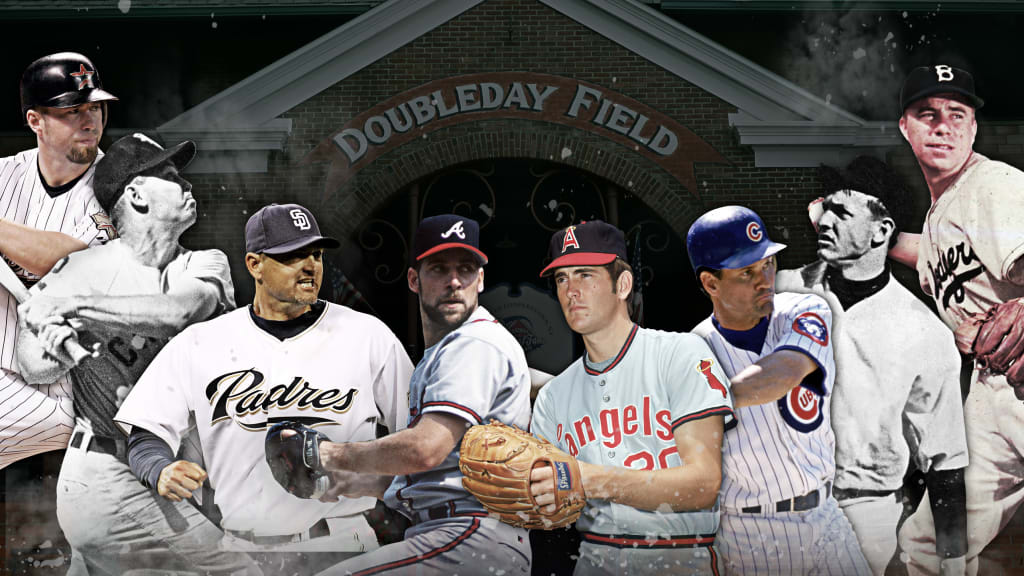
A general manager’s worst nightmare has to be rooted in regret. No one wants to be remembered for trading a player who goes on to become an icon elsewhere. That’s perhaps where some of the strongest apprehension lies when considering dipping into their prospect pools.
Yet such stories are littered across baseball history, some of them among the most well-chronicled. And while we all know examples like the Curse of the Bambino, we wanted to dig a little deeper.
Which players were traded so early in their careers that the transaction might’ve been forgotten among the mainstream? Take the most recent player elected to the Hall of Fame, Fred McGriff. When the Crime Dog was a relatively unknown 19-year-old Minor Leaguer less than two years removed from being a ninth-round Draft pick, the Yankees shipped him to the Blue Jays. It was the first of four times McGriff would be dealt, and this one didn't work out too well for New York.
Below, we looked at eight more such instances, factoring in shock value (with the luxury of hindsight), and listed them in reverse chronological order. The criteria: All players were dealt before accruing three years of service time and then put themselves on a Hall of Fame track with their acquiring club.
Friars’ fire sale wasn’t all bad
Padres got: Trevor Hoffman, Andres Berumen, José Martínez
Marlins got: Gary Sheffield, Rich Rodriguez
Date: June 24, 1993
This one isn’t forgotten by Marlins or Padres fans, but given how synonymous Hoffman became with San Diego and that the reaction was centered on Sheffield, it deserves mention here. Hoffman had pitched in just 28 mostly low-leverage games for the Marlins in 1993, but he’ll never forget his first few with the Padres, as Friars fans rained boos on Hoffman as a sign of disapproval of the trade. It took a while to win them over, but the trade led to a win-win for both parties.
Sheffield helped the Marlins win the 1997 World Series and continued his own Hall of Fame trajectory, receiving 40.6% of the vote in 2021, his sixth year on the ballot. Hoffman pitched 16 seasons in San Diego, set the MLB saves record (since broken by Mariano Rivera) and joined Tony Gwynn as the only players in Cooperstown enshrined as Padres.
Pack your Bags
Astros got: Jeff Bagwell
Red Sox got: Larry Andersen
Date: Aug. 30, 1990
Bagwell -- born in Boston and raised in Connecticut -- went from describing himself immediately after the trade as “one of the saddest guys you'll ever see” to later saying, “the worst moment of my life turned out to be the best moment of my life,” according to Sports Illustrated.
Bagwell, 22, was dealt for Andersen, 37, in a move justified by the Red Sox due to their dire need for bullpen help in a pennant chase, and Andersen did prove to be valuable. He posted a 1.23 ERA in 15 games and Boston won the division, though Andersen went on to sign with the Padres that offseason.
At the time a third baseman, Bagwell was blocked by Hall of Famer Wade Boggs in Boston and eventual All-Star Scott Cooper at Triple-A Pawtucket. And, as Bagwell later said, if the Sox ever needed, they could always buy free agents. That gave the club little pause to trade Bagwell, who went on to win the National League Rookie of the Year Award the following year, his first of 15 seasons in the Majors -- all for the Astros.
Smoltz heads South
Braves got: John Smoltz
Tigers got: Doyle Alexander
Date: Aug. 12, 1987
The Tigers were in a pennant race, in need of starting pitching and set on acquiring Alexander from Atlanta, which, according to Baseball-Reference, had its initial four-player request denied. That’s when a Braves scout who had seen Smoltz in the Minors suggested that Atlanta center talks on the righty, who wasn’t exactly a bluechip prospect. The 20-year-old Smoltz had labored to a 5.68 ERA and 1.631 WHIP at Double-A that season and just two years prior was a 22nd-round Draft pick.
It’s worth noting that Alexander wasn’t an afterthought. He went undefeated, going 9-0 with a 1.53 ERA in 11 starts with Detroit after the trade to help the Tigers reach the American League Championship Series. The following season, he was an All-Star.
Skip Caray’s analysis at the time illuminates the logic from both sides:
But the Tigers wouldn’t reach the postseason again until after Smoltz’s 20-year career in Atlanta concluded, over which he pitched in 40 postseason games. To add further shock value: Smoltz is Detroit born-and-bred and could’ve become as homegrown of an ace as they come.
Ryno to Chicago
Cubs got: Ryne Sandberg, Larry Bowa
Phillies got: Iván de Jesus
Date: Jan. 27, 1982
Maybe the Phils were intent on extending a golden era by acquiring MLB-ready talent. It at least seems clear that they didn’t know just what they had in Sandberg. Instead of moving him from shortstop, where he played in the Minors, to second, which the Cubs did upon acquiring him, the Phils shipped the then-prospect Sandberg and an aging Bowa to Chicago in exchange for de Jesus.
Sandberg was one of many shortstop prospects in line to replace Bowa, along with Julio Franco, and moving Sandberg to third was out of the question, with Mike Schmidt on a Hall of Fame trajectory. de Jesus also played short and was seven years younger than Bowa, and the Phils had been shopping Sandberg to other clubs, so he wasn’t exactly a “throw-in” to the trade.
But the hindsight has to still sting. De Jesus posted a 78 OPS+ in three underwhelming seasons with Philly, while Sandberg became an MVP, a 10-time All-Star and one of the greatest second basemen of all time.
Not so Amazin’
Angels got: Nolan Ryan, Frank Estrada, Don Rose, Leroy Stanton
Mets got: Jim Fregosi
Date: Dec. 10, 1971
“The Mets finally gave up on Nolan Ryan’s wandering fastball,” read the New York Times’ lede the day that the club traded Ryan and three prospects to the Halos for star shortstop Fregosi. It’s easy to highlight this as a huge Mets blunder, but at the time, one could at least entertain their logic.
The Mets were coming off third- and fourth-place finishes in 1970 and '71 and felt they needed a jolt to their pedestrian offense. Fregosi was a six-time All-Star and had a career 115 homers. Ryan, despite averaging nearly a strikeout per inning, had a ghastly walk rate of 15.4% and had lost more games (38) than he’d won (29), which were stats teams lived by back then.
Yet even though Ryan had pitched parts of five seasons by then, he was still just 24 years old, threw absolute gas and was oozing with potential. Ryan’s command would remain an issue -- his career 12.4% walk rate is by far the highest among Hall of Famers -- but that would take a back seat en route to him becoming the game’s all-time strikeout king. Fregosi, meanwhile, hit just .233/.319/.328 for New York and was shipped to Texas the following season.
Whoa, Nellie
White Sox got: Nellie Fox
A’s got: Joe Tipton
Date: Oct. 19, 1949
Fox had a pedestrian .632 OPS in three partial seasons backing up A’s second baseman Pete Suder. That prompted Connie Mack to trade Fox for White Sox catcher Tipton, which led Fox to another backup gig in Chicago -- this time behind All-Star Cass Michaels.
But Fox caught a break when the White Sox dealt Michaels to the Senators, which paved the way for Fox to finally get consistent at-bats. Yet even then, he had a .608 OPS in his first year in 1950 and was clearly a player who required patience. Finally, Fox hit his stride in ’51, when he was an All-Star for the first of 11 straight seasons.
Mack was widely known as one of the best talent evaluators ever, and Fox was more of a diamond in the rough, but it’s clear that he misjudged here. Tipton was just a .204 hitter when he was acquired, which perhaps shows the ballpark in which they valued Fox.
Brooklyn’s Little Colonel
Dodgers got: Pee Wee Reese
Red Sox got: $35,000 and two players to be named later (Red Evans, Art Parks)
Date: July 18, 1939
Had it not been for positional incumbency, Reese might have gone on to be a Red Sox great instead of the captain of The Boys of Summer Brooklyn Dodgers. Reese was surging through the Minors with the Louisville Colonels, who had no MLB affiliation, when Boston owner Tom Yawkey purchased the club -- many reports suggest -- solely to retain Reese’s rights. But, as Roger Kahn postulates in "The Boys of Summer," then-manager Joe Cronin was also Boston’s starting shortstop and wanted to retain his position. So he pushed to trade Reese.
After Reese was dealt to the Dodgers, he finished his season in Louisville, then broke into the Majors the following year. He went on to become a team captain, a 10-time All-Star, a 1955 World Series champion, and perhaps most notably, a champion for Jackie Robinson and integration.
Christy the Redleg …?
Giants got: Christy Mathewson
Reds got: Amos Rusie
Date: Dec. 15, 1900
Mathewson’s story begins and ends with him as a Giant, and as such, it’s quirky. After going winless with a 5.08 ERA in an abbreviated first MLB season, the Giants demoted Mathewson to the Minors, which led the Reds to select him in the Rule 5 Draft. But before he’d ever suit up for Cincinnati, Mathewson was dealt back to the Giants for Rusie, who was in the twilight of his Hall of Fame career.
So there went the chance for Mathewson to blossom within the Redlegs’ rich history. Or was it?
According to SABR, the Giants would’ve had to pay the Minor League team $1,000 to take Mathewson, and the Reds only paid $100 to draft him away. So the entire ploy was to save $900 and send away Rusie, who made just three starts for the Reds.
